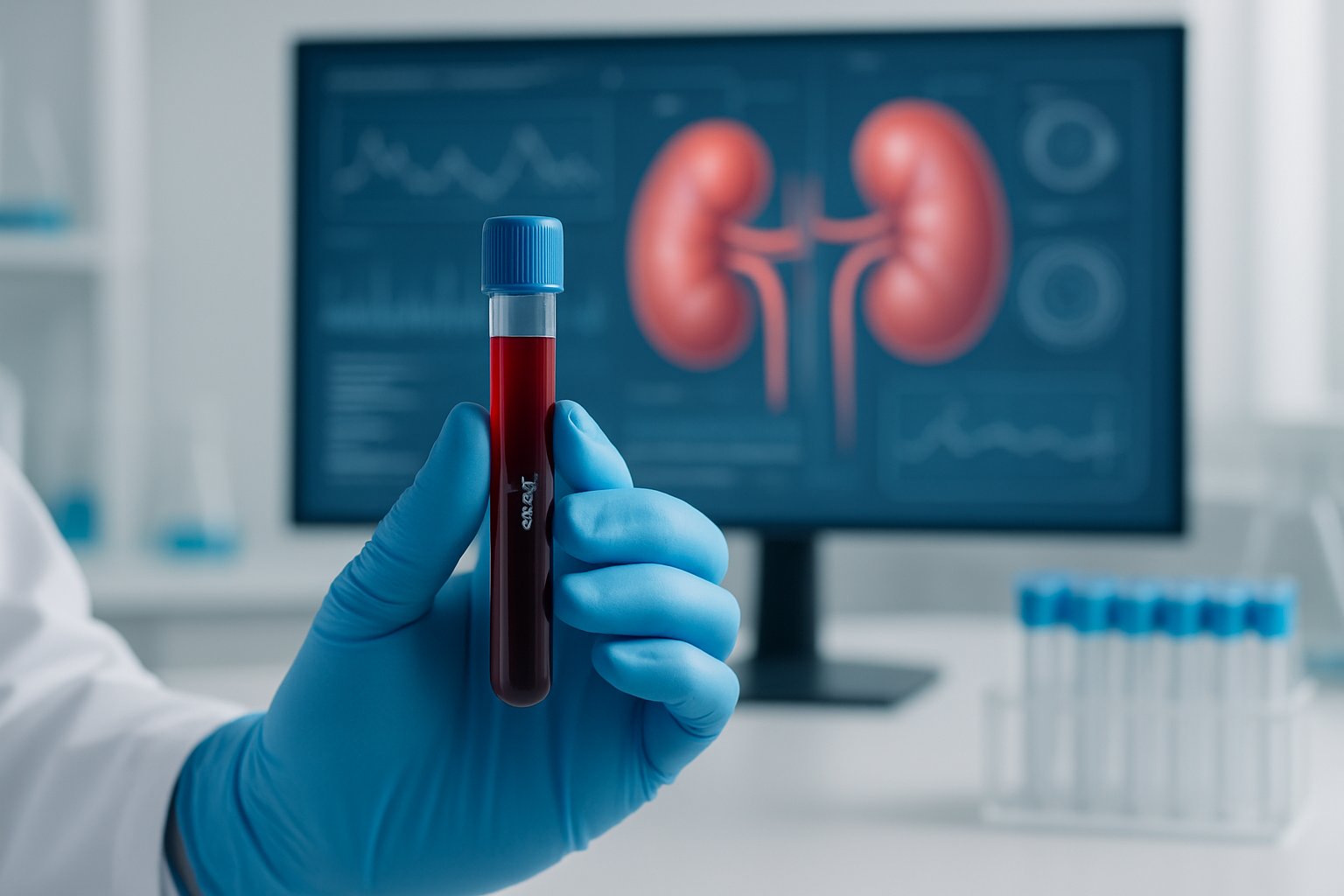High BUN levels may indicate kidney damage, while low levels can indicate liver disease or poor nutrition. Diet, hydration, medications, and underlying health conditions all play a role in BUN results. The comparison between BUN and creatinine values helps doctors determine if elevated BUN comes from kidney damage or other causes.
When doctors order blood tests to check kidney function, the BUN test often raises questions about what the results mean. BUN measures urea nitrogen in the blood, which comes from protein breakdown in the liver and gets filtered out by healthy kidneys.

Having BUN levels within the normal range of 6-20 mg/dL is ideal, as both high and low levels can signal health problems. High BUN levels may indicate kidney damage[1], while low levels can point to liver disease or poor nutrition. Most doctors worry more about high BUN levels because they often mean the kidneys are not working properly.
Understanding what affects BUN levels helps people make better health choices.
Should You Have a Low or High BUN Level?

Neither extremely low nor extremely high BUN levels are ideal for health. The goal is to maintain BUN values within the normal range, which indicates proper kidney function and overall metabolic balance.
Significance of BUN Levels in Health
BUN levels serve as a key indicator of how well the kidneys filter waste from the blood. Blood urea nitrogen measures the amount of nitrogen in blood[1] that comes from urea, a waste product created when the body breaks down proteins.
The kidneys remove about 85% of urea from the bloodstream. When kidney function declines, BUN levels typically rise because the kidneys cannot filter waste effectively.
Healthcare providers use BUN tests to screen for kidney problems early. This is important because many people with kidney disease have no symptoms in the early stages.
BUN values also help doctors monitor existing kidney conditions. They can track whether treatments are working or if kidney function is getting worse over time.
Healthy BUN Range and Reference Values
Normal BUN levels range from 7 to 20 mg/dL for most adults[2]. However, the exact range can vary slightly between different labs and testing methods.
BUN Reference Values by Age:
- Adults: 7-20 mg/dL
- Children: 5-18 mg/dL (about two-thirds of adult levels)
- Elderly: May have slightly higher normal ranges
BUN values can change based on factors other than kidney function[3]. Diet affects BUN levels significantly. People who eat high-protein diets often have higher BUN values.
Hydration status also impacts results. Dehydration can cause BUN levels to rise temporarily, even when kidney function is normal.
Implications of High BUN Levels
High BUN levels usually signal problems with kidney function or other health issues. BUN levels above 20 mg/dL are considered elevated[4] and require further evaluation.
Causes of High BUN Include:
- Chronic kidney disease
- Acute kidney injury
- Dehydration
- High-protein diet
- Internal bleeding
- Heart failure
- Certain medications
Severely high BUN levels above 50 mg/dL indicate serious kidney problems[4]. BUN values over 100 mg/dL represent a medical emergency requiring immediate treatment.
High BUN can cause symptoms like fatigue, nausea, confusion, and swelling. These symptoms occur because waste products build up in the blood when kidneys cannot filter properly.
Risks of Low BUN Levels
Low BUN levels are less common but can indicate certain health problems. BUN values may be low in people with liver disease[3] because the liver cannot produce urea normally.
Conditions That Cause Low BUN:
- Liver disease or liver failure
- Severe malnutrition
- Low-protein diet
- Overhydration
- Pregnancy (due to increased blood volume)
Very low BUN levels might suggest the body is not breaking down proteins properly. This can happen when someone is not eating enough protein or has problems absorbing nutrients.
Low BUN is generally less concerning than high BUN. However, it still needs medical evaluation to determine the underlying cause and appropriate treatment.
Main Causes and Health Effects of Abnormal BUN Levels

BUN levels can shift outside normal ranges due to kidney problems, dietary factors, hydration status, and various medical conditions. Understanding what causes these changes and how they relate to other kidney markers helps doctors assess kidney function and overall health.
Factors That Raise BUN
Several conditions can cause BUN levels to rise above normal ranges. Kidney problems are the most serious cause, as damaged kidneys cannot filter urea nitrogen properly from the blood.
Kidney-Related Causes:
- Kidney disease or kidney damage
- Kidney stones blocking urine flow
- Kidney failure or renal failure
- Low glomerular filtration rate (GFR)
Non-Kidney Causes: Dehydration is a common reason for elevated BUN levels. When the body lacks water, BUN becomes more concentrated in the blood.
A high-protein diet can increase BUN levels[1] because more protein breakdown creates more urea nitrogen waste. This happens through the urea cycle in the liver.
Other factors include:
- Heart disease or congestive heart failure
- Gastrointestinal bleeding
- Certain medications
- Burns or severe stress
- Advanced age
Causes of Low BUN Levels
Low BUN levels are less common but can indicate specific health issues. Liver disease often causes low BUN[1] because the liver cannot properly process proteins through the urea cycle.
Main Causes of Low BUN:
- Liver damage or poor liver function
- Low-protein diet or malnutrition
- Overhydration (too much water dilutes BUN)
- Small body size
- Pregnancy (increased blood volume dilutes BUN)
Severe liver disease affects protein breakdown and amino acid processing. This reduces urea production, leading to lower BUN levels in blood samples.
People on very low-protein diets may also have reduced BUN levels. The body produces less urea nitrogen when protein intake is limited.
Interpreting BUN Alongside Creatinine
Doctors rarely use BUN alone to diagnose kidney problems. The BUN to creatinine ratio provides more accurate information about kidney function and helps identify the cause of abnormal levels.
Normal BUN/Creatinine Ratio: 10:1 to 20:1
A high BUN/creatinine ratio often indicates:
- Dehydration
- Heart disease
- Gastrointestinal bleeding
- High protein intake
A low ratio may suggest:
- Liver disease
- Low protein diet
- Overhydration
Both tests appear in a basic metabolic panel or comprehensive metabolic panel. Creatinine levels change mainly due to kidney function, while BUN responds to other factors like diet and hydration.
Managing and Monitoring BUN Levels
Treatment for abnormal BUN levels depends on the underlying cause. Kidney problems require different approaches than dietary or hydration issues.
For High BUN Levels:
- Treat underlying kidney disease
- Adjust protein intake if too high
- Improve hydration status
- Manage diabetes and heart disease
- Monitor with regular blood tests
People with kidney failure may need dialysis to remove excess urea nitrogen. Kidney transplant patients require ongoing monitoring of their BUN test results.
For Low BUN Levels:
- Address liver function problems
- Improve nutrition if malnourished
- Adjust fluid intake if overhydrated
- Monitor protein intake
Regular monitoring through metabolic panels helps track changes over time. Doctors use BUN trends along with GFR and creatinine to assess kidney function progress.
Patients with diabetes, heart disease, or known kidney problems need more frequent BUN monitoring to prevent complications.
Frequently Asked Questions

High BUN levels can signal kidney problems but may also result from dehydration or high protein intake. Low BUN levels are less common and usually indicate liver issues or overhydration.
What symptoms indicate high BUN levels in the blood?
High BUN levels often develop without early symptoms. However, when kidney function declines significantly, several warning signs may appear.
People with elevated BUN levels may experience increased urination, foamy urine, or blood in their urine[1]. These symptoms suggest the kidneys are struggling to filter waste properly.
Other symptoms include fatigue and loss of appetite. Swelling in the hands, feet, and ankles may also occur as fluid builds up in the body.
What could be the implications of having symptoms associated with low BUN levels?
Low BUN levels are uncommon and typically less concerning than high levels. They usually indicate the body is producing less urea or diluting it with excess fluid.
Symptoms of low BUN may include weakness or confusion from overhydration. Some people may experience nausea or headaches when their body’s fluid balance is disrupted.
Low BUN can signal liver problems since the liver produces urea. People with severe liver disease may have difficulty making enough urea nitrogen.
How can one assess the significance of their BUN/creatinine ratio?
The BUN/creatinine ratio helps doctors understand kidney function better than BUN alone. A normal ratio typically falls between 10:1 and 20:1.
High ratios may indicate dehydration, heart problems, or urinary blockages. Low ratios often suggest liver disease or muscle wasting conditions.
Healthcare providers use both BUN and creatinine levels together to evaluate kidney failure[1]. Neither test alone provides a complete picture of kidney health.
What are recognized methods to reduce elevated BUN levels?
Reducing BUN levels depends on the underlying cause. People with kidney problems need medical treatment to address the root issue.
Staying well hydrated helps the kidneys filter waste more effectively. Drinking adequate water can lower BUN levels caused by dehydration.
Reducing protein intake may help lower BUN levels temporarily. However, people should consult their doctor before making significant dietary changes.
Managing conditions like diabetes and high blood pressure protects kidney function. These steps can prevent BUN levels from rising further.
What constitutes a dangerously high BUN level?
BUN levels above 100 mg/dL typically indicate severe kidney dysfunction. At this level, people usually need immediate medical attention or dialysis.
BUN levels between 50-100 mg/dL suggest significant kidney problems. People at this range often experience noticeable symptoms and need close medical monitoring.
The exact level considered dangerous varies by individual health conditions. Age, muscle mass, and other medical problems affect what levels are concerning for each person.
What is considered to be within the normal range for blood urea?
Normal BUN ranges vary by age and gender. Children between 1 and 17 years typically have BUN levels between 7 and 20 mg/dL[1].
Adult women usually have BUN levels between 6 and 21 mg/dL[1]. Men tend to have slightly higher normal ranges.
Adult men typically show BUN levels between 8 and 24 mg/dL[1]. These ranges can vary slightly between different laboratories and testing methods.
References
- Blood Urea Nitrogen (BUN): Testing, Levels & Indication. https://my.clevelandclinic.org/health/diagnostics/17684-blood-urea-nitrogen-bun-test Accessed October 24, 2025
- Blood urea nitrogen (BUN) test for kidney disease. https://www.kidneyfund.org/all-about-kidneys/tests/blood-urea-nitrogen-bun-test Accessed October 24, 2025
- What Level of BUN Indicates Kidney Failure? Stages. https://www.medicinenet.com/what_level_of_bun_indicates_kidney_failure/article.htm Accessed October 24, 2025
- High BUN Levels Explained: Symptoms, Causes, and Tests You Need to Know. https://www.rupahealth.com/post/high-bun-levels-explained-symptoms-causes-and-tests-you-need-to-know Accessed October 24, 2025
